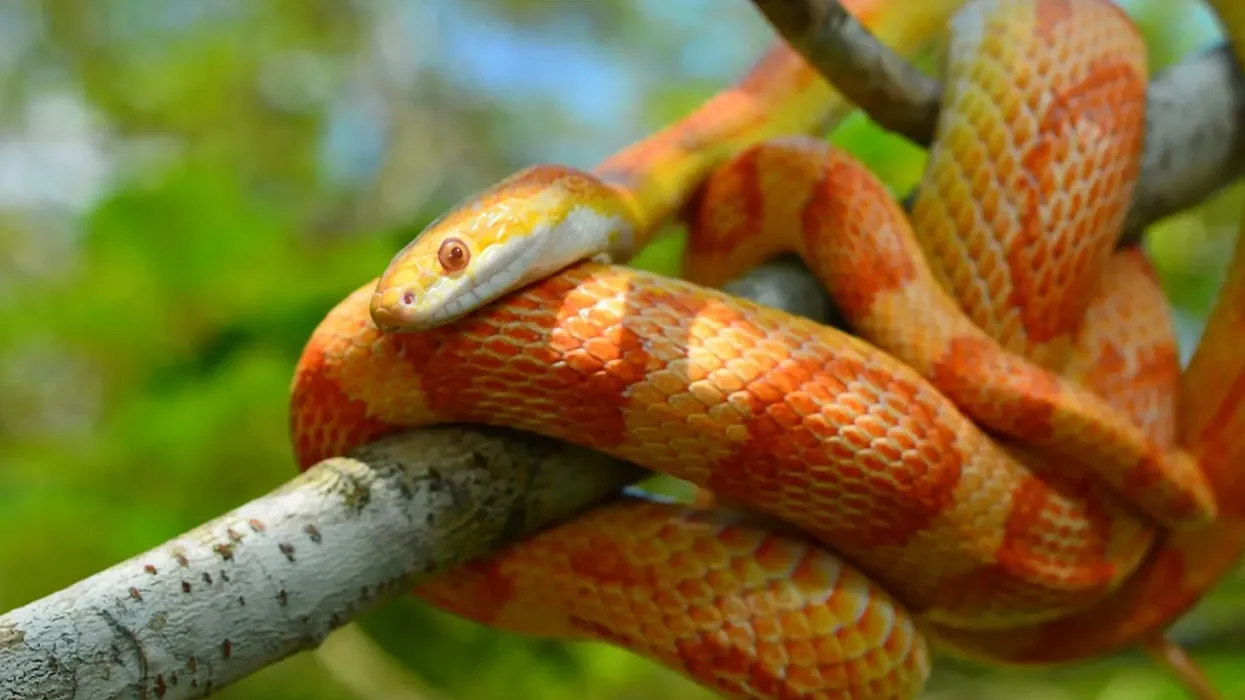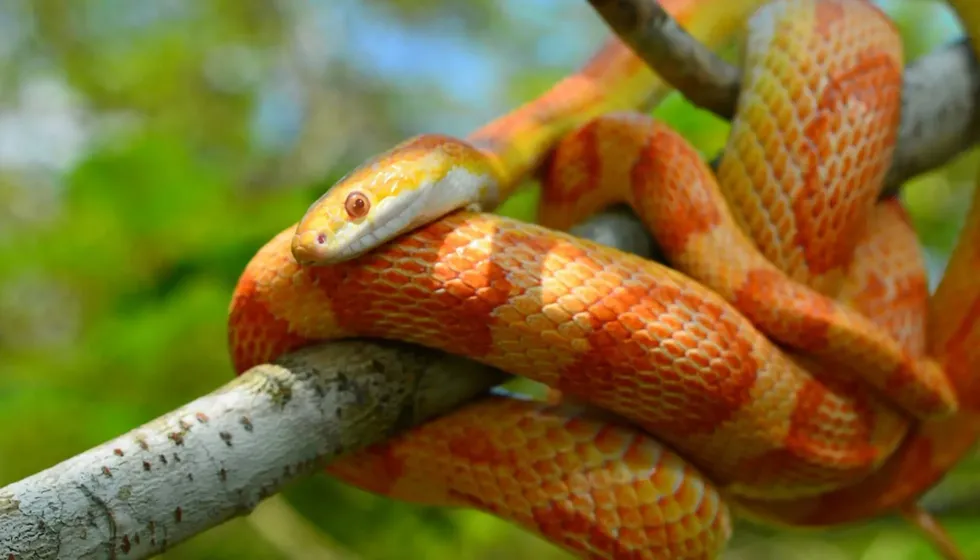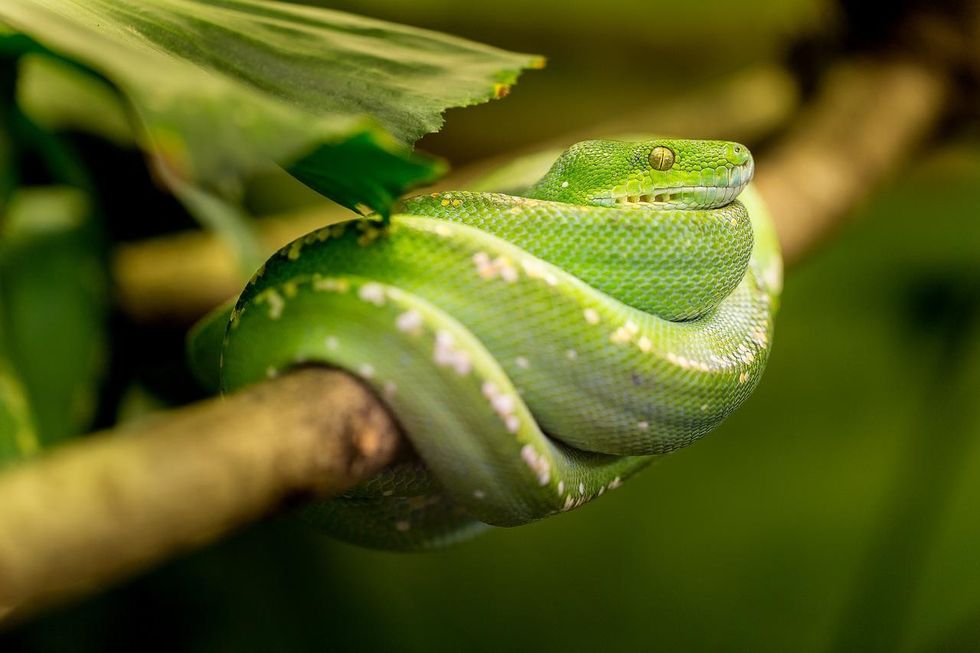If you want to learn about reptiles that can easily be kept as pets, then you would love to read about the Corn Snake. The Corn Snake is a species of snakes found in large numbers in the United States of America all over North America and the Caribbean Islands, especially in the states of Florida and Louisiana.
They are beautiful in appearance and have unique checkerboard patterns on their belly that have led to them being called Corn Snakes. These snakes are non-venomous They hunt by wrapping themselves around the prey and constricting it.
They swallow the food whole after the constriction.
Humans, however, do not need to worry as they are safe from being strangulated by them.. On the contrary, they are beneficial to humans as they are known to hunt rodents that roam around croplands. They are also great as house pets due to their calm demeanor and easy-to-care nature.
So, what are you waiting for? Read on about these unique reptiles.
For more information on snakes, you can take a look at green anaconda and rattlesnake.
Corn Snake Interesting Facts
What type of animal is a Corn Snake?
The Corn Snake also called the Red Rat Snake, belongs to a species of rat snakes that are known to prey on rodents and other reptiles by constricting them. Found both in the wild and in homes as pets, these snakes are non-venomous in nature.
What class of animal does a Corn Snake belong to?
Corn Snakes belong to the class of Reptilia and to the family Colubridae. Pantherophis guttatus is their most commonly used scientific name, while Elaphe guttata is also used at times for adult corn snake species.
How many Corn Snakes are there in the world?
Corn Snakes are found in abundance on the continent of North America. However, due to their abundance, there is no clear data on the total number of Corn Snakes that exist in the wild.
Estimating the total population also becomes a problem because there are many Corn Snake morphs that are bred to be designer pet snakes. Thus, their IUCN status is Least Concern.
Where does a Corn Snake live?
The Corn Snake is known to live in the wild forests and grasslands of United States of North America. States like Florida, Louisiana, Kentucky, and New Jersey are some of the states where Corn Snakes are found.
It is generally considered that this species of rat snakes are most abundant in the state of Florida. They are also found in some of the Caribbean Islands like the Lesser Antilles, Grand Cayman, and the Bahamas as a result of being introduced there artificially.
More often than not, Corn Snakes are seen in trees in rocky woodlands, meadows, rocky open areas, and grasslands. In states like Florida, they're often found in abandoned buildings and farm barns.
Many Corn Snakes are bred to be pets and these adults almost grow up entirely in the captivity of human homes.
What is a Corn Snake's habitat?
Corn Snakes are observed in the habitat of meadows, open areas, and grasslands along with farm barns and abandoned buildings and sites. However, these snakes are known for their secretive behavior.
They are a diurnal species known to be most active during the daytime. These species, which are commonly found in Florida, exhibit behavior that shows that they can easily enter abandoned buildings or climb up trees in search of prey.
They are known to hide under logs, debris, loose tree barks that are part of their wild habitat during the day. In terms of sleep, Corn Snakes like other snakes can sleep up to 16 hours in a day.
Interestingly, Corn Snakes are known for brumation. This means that during cold winter in some regions, they can go without food for months remaining dormant.
They only wake up from their slumber during these cold winter months to drink water. However, in places where the drop in temperature in winter is not so steep, adult Corn Snakes can be found sheltering under rocks and logs, and houses where they are often observed coming out to soak the warm sun in winter.
Who do Corn Snakes live with?
Corn Snakes are snake species that are very solitary in nature. They do not live or hunt for food or prey in groups. When in captivity, the adults of this species have also shown an increase in stress and discomfort in health when housed together with other corn snakes.
How long does a Corn Snake live?
In the wild, Corn Snakes are known to live for around six to eight years. However, when kept in captivity, their average lifespan significantly increases. In captivity, the average lifespan increases to around 20-23 years. The age of the oldest corn snake known was reportedly 32 years and three months.
How do they reproduce?
The reproduction pattern of Corn Snakes is unique in nature. Male corn snakes mature sexually at about two years of age, while females mature at over three years of age but need to be at least 3 ft (91 cm) in length and weigh 0.6 lb (300 g)..
In captivity, they are one of the easiest snakes to breed, with breeders often putting these snakes through a period of brumation before mating.
In the wild, mating, too, occurs between the months of March and May after the winter is over.
During the reproduction process, males have been observed to woo females with certain chemical cues and tactile signals. Females may be chased by males for hours in an attempt to mate.
Once the snakes have mated, the gestation period lasts for around 60-65 days. In keeping with their solitary nature, female Corn Snakes do not show any motherly instincts.
Once they give birth to the eggs, they leave them. The clutch size is anywhere between 3-30 eggs but the usual range is around 12-24. Eggs are usually kept in decaying piles of vegetation so that get sufficient heat that is required for the incubation.
After a period of 65 days, the eggs hatch at a temperature of 85 degrees Fahrenheit, and young corn snakes come out. Many hatchlings die young because they have to fend for themselves from the very first day of their birth.
What is their conservation status?
According to the International Union For Conservation Of Nature Red List, Corn Snakes have been listed as Least Concern. This species found all over places like Florida in great numbers, is in no immediate danger of seeing its population decline.
However, many corn snakes are killed every year, owing to their physical similarities with the venomous pit viper snake known as the Copperhead.
Corn Snake Fun Facts
What do Corn Snakes look like?
Among snakes, Corn Snakes are popular for their distinct look. Also known as the Red Rat Snake, they are known for their pattern of red, large blotches that are bordered with black.
These snakes usually have orange or yellowish-brown scales on which the red blotches appear. Sometimes these blotches can also be orange in color encircled in black markings.
The most interesting bit is the black and white checkerboard pattern that is situated on their belly. This black and white pattern on their belly is what many people believe to be the original reason for the name 'Corn Snakes'.
An adult of this species also has a unique spear-shaped pattern on the top of its head. However, adults are often confused with the venomous Copperhead snake.
Easy ways to distinguish between corn snakes and copperheads are through the more colorful patterns on the corn snakes, along with their slender build and larger pupils situated on the head of these snakes. Corn snakes are also known to lack heat-sensing pits.
As these snakes are very popular as pets, they have been bred to produce different color patterns including variations in red, orange, yellow, black, and white. Some of the variations include changes in the pattern on the head and the belly, with snakes such as Albino Corn Snakes and Snow Corn Snakes being primarily white in color.

How cute are they?
Corn Snakes with their beautiful color variations and shy attitude are considered by many to be very cute animals. These Corn Snakes can be often found slithering into the hands and shoulders of their owners in captivity.
They are thought to be highly intelligent snakes who can very easily adapt to their surroundings and many people might find their intelligence to be cute.
How do they communicate?
Corn Snakes are known to communicate via their sense of smell. During mating, communication can also be established through chemical and tactile cues.
For these snakes, the odor cues help greatly in detecting their prey. Younger snakes are known to rely more on their olfactory senses while adults and older snakes are known to rely more on their sense of sight.
How big is a Corn Snake?
Adults of this species are known to grow anywhere between 2-5 ft (61-152 cm). There have been records, however, of Corn Snakes growing up to as much as 6 ft(182 cm) in length. These Red Rat Snakes are almost one-fifth the average size of the Burmese Python which is also a nonvenomous constrictor.
How fast can a Corn Snake move?
These snakes are not known to be very fast. They rely more on stealth than speed in order to attack their prey.
How much does a Corn Snake weigh?
For a snake, Corn Snakes are comparatively light. Their weight ranges anywhere between 1.5-2 lb (0.7-0.9 kg).
What are their male and female names of the species?
Like any other snake, Corn Snakes that are adults do not have distinct names to separate males and females.
What would you call a baby Corn Snake?
Baby snakes are commonly called hatchlings, snakelets, or neonates. These names apply to babies of Corn Snakes as well.
What do they eat?
Corn Snakes eat rodents, lizards, birds, and bird eggs as part of their diet. Their food habits and their diet are beneficial to humans as they can keep in check the population of rodents in large fields and croplands.
During the initial months, hatchlings feed themselves on small frogs and lizards but once they are large enough, they start preying on bigger animals. In captivity, these snakes do not need to be fed very often because they have evolved into eating every few days.
Are they poisonous?
Corn Snakes are not dangerous to human beings in the sense that they do not contain any functional venom. However, when threatened they might bite their prey or even humans. They are known for having a long striking range that goes up to about one-third to half of their body length.
Would they make a good pet?
Corn Snakes make for great pets. In fact, they are some of the most commonly found reptile pets all over the world. Many believe that only the Ball Python is more popular than the Corn Snake as a pet.
In places like Florida and some of the other states in the US, these snakes are very commonly found pets. There are few things that work in their favor as pets.
Firstly, they have an average size. They are also generally calm and even allow their owners to handle them for long periods of time. Lastly, they do not have any significant health problems and are easy to care for.
Did you know...
There have been mixed breedings between Corn Snakes in captivity with the California Kingsnake to produce hybrids that are called Jungle Corn Snakes.
They can be found at altitudes as high as 6,000 ft.
Like other snakes of their family, Corn Snakes are known to exhibit the tail vibration defense mechanism when threatened.
Naming the Corn Snake
Known for strangling their prey due to being constrictors, there are two anecdotes that explain their name. It is said that the name of this snake originated from the fact their checkerboard pattern on the belly was very similar in comparison with the kernels of corn or maize.
They might also have derived this name from being found near grain stores and corn fields where they would hunt for rodents.
Getting your own Corn Snake
Due to this snake being quite popular, there are plenty of breeders all around the world. Corn Snakes can be found from breeders starting at $90 with some color morphs being sold at $200.
Here at Kidadl, we have carefully created lots of interesting family-friendly animal facts for everyone to discover! Learn more about some other reptiles including sand lizard, or copperhead snake.
You can even occupy yourself at home by drawing one on our Corn snake coloring pages.










